Before you start to create your own food delivery app, it is a wise move to explore the market that is now actively searching the adequate response to bans on dining in restaurants, and define what niche of food delivery service suits your business goals.
Below, you find stats and factors that are worth considering.
Make a tour around the market
Food delivery used to be a traditional extension of restaurant business to remove location constraints on reaching new customers. But now food delivery segments expanded and include the delivery of meals provided by restaurants either via special platforms or a restaurant website. Another considerable segment includes on-demand food delivery apps that operate as courier service.
According to McKinsey, the food-delivery market is growing faster compared to other sectors of delivery service industry. The popularity of the trend for food delivery app development is determined by:
- High demand on delivery service corresponding to the idea of maximum customer convenience
- Search for ways of maintaining the restaurant business under the conditions of social distancing and global lockdown.
Recent market overview demonstrates staggering numbers: according to Statista, the revenue in the online food delivery segment reaches more than $136 million in 2020 and is forecast to grow by 7.5% leading to increase of a market volume of over $182 million by 2024.

The global and local major market players like UberEats, GrubHub, Zomato, Swiggy, Seamless, Eat 24, Deliveroo present diverse business models available on food delivery market.
Define what food delivery business model you want
The most popular business models of online food delivery app include:
- aggregator model
- order and delivery app model
- full stack model
Below, there is an overview of the named models along with the examples of apps that proved their longevity on the market.
Aggregator Model
It includes the third party food delivery apps model and implies ordering as the primary function of the app. The aggregator model was the first to appear on food delivery market and offered the service of a mediator ‘erasing’ the distance between clients and their favorite restaurants.
This model is based on providing the access to a wide variety of restaurants. The users upon login, navigate through the list of restaurants, read their reviews and opt for the menu of their choice. At next step, customers place an order, which is further processed for delivery.
The popular apps from this category:
Zomato
Zomato is a food delivery service that positions itself as a social network for foodies.
The app functionality supports the delivery service at a very high level of quality. What is more, it works as a social network for people cognizant in food. Consumers not just explore menu of nearby restaurants but feel a part of extensive ‘foodie community’.
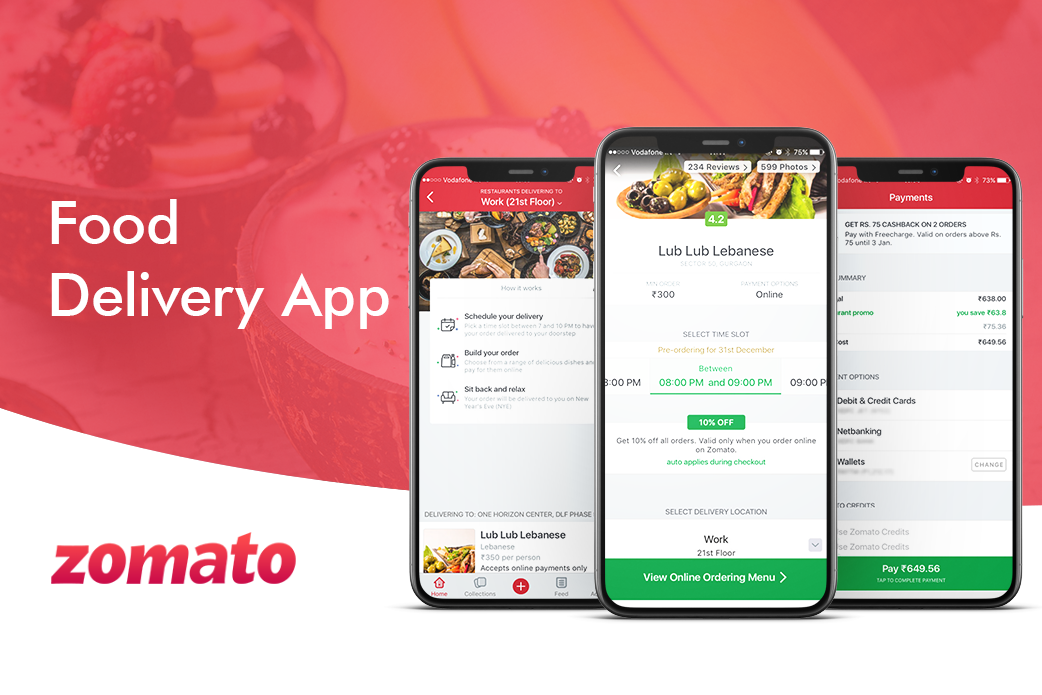
FoodBoss
FoodBoss took it a step further: it enables users to search several food delivery apps at the same time. It uses an aggregator model to gather data on food delivery services from available restaurants and introduce best deals and real-time pricing.
The app can compare data collected from more than 50 cities. FoodBoss plans to further explore contactless delivery options as the timely response to the coronavirus.
✔As a side note: The new-delivery apps that appeared in 2013 aim at extension of food delivery by providing logistics to partner restaurants. Directing consumers to a new group of restaurants lets new-delivery platforms compete successfully with the aggregators. In all probability, we can witness lower-end traditional-delivery restaurants turn to featuring on new delivery apps for the reason of cost efficiency.
The order and delivery app model
This type of app offers allocation the order and takes care of delivering the order to customer. Restaurants welcome collaboration with these apps as it brings them additional orders. Once order is placed, it is sent to independent delivery persons available for picking up the order. The courier claims the order and delivers it. The data accumulated while service is performed helps identify logistics patterns and build more optimized routes.
The most famous apps of this kind are:
UberEats
UberEats service provides food delivery in more than 1000 cities worldwide. It lets a customer choose the menu from lots of restaurants, and independent drivers bring their order in no time. UberEats can connect to almost any restaurant and it means that the order placement takes a tap. It also provides cashless transactions for extra safety.
DoorDash
It is one of the most successful food delivery apps widely known across North America.
It offers different search filters and lets consumers choose the closest restaurant or fastest delivery effortlessly. Aside from option for quick order placement and order tracking, the app offers a reorder option, which means that delivery of customer’s favorite dish can be optimized to ‘one click and pick’.
Full-stack model
Implementing this app means that consumers get the full-fledged food delivery on their fingertips. The app functionality implies incorporation of all the service stages from cooking to charging.
Practically, the app operates on three interconnected apps for the courier, the restaurant, and separately, for the consumer. Initially, the order moves automatically from the customer to the restaurant. Once the meal is cooked, the restaurant ensures that the order can be transported to the customer by couriers who are ready to pick the order upon notification from the restaurant. It locks the cycle fast because this app design satisfies the needs of all parties.
One of the examples of this kind of app is Dahmakan whose total funding reached $28 million.
Dahmakan
This full-stack platform based in Malaysia is an operating system embodying all the steps from recipe development to delivery to the consumer’s door, and its ‘cloud’ kitchens are linked in hubs across different cities to be in vicinity of their customers.
Dahmakan prepares its own meals featuring up to 40 options each week from a database of 2,000 dishes. It picks its weekly offers on the basis of consumer data analysis of food preferences along with spending habits.
Set the requirements and define user roles
There are three types of the food delivery apps according to whom they are designed for: customers, restaurants or couriers that must be regarded as the end-users and whose requirements must be cornerstones of development.
In particular, the customer app aims at creating a portal through which all the orders will be made.
The admin panel of the restaurant app must ensure efficient supervision of all the requests.
The delivery person app implies creating the interface for convenience of a courier.
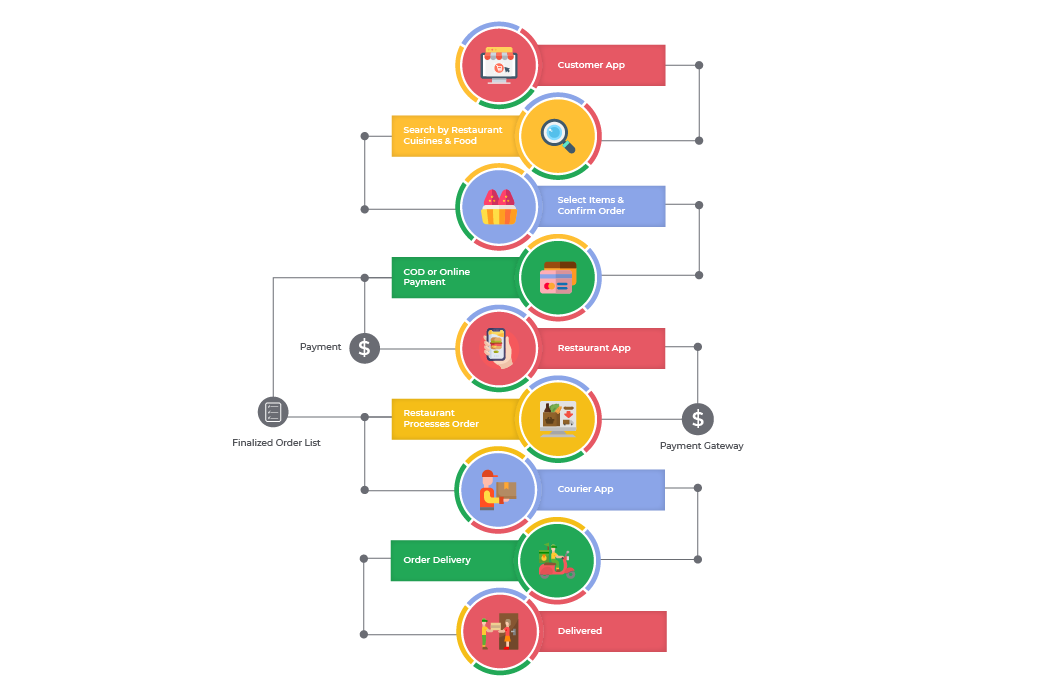 At the stage of business analysis, it is very important to do complete research of your target market and define the end-user in terms of creating their consumer portrait that will help set specific requirements prior to development.
At the stage of business analysis, it is very important to do complete research of your target market and define the end-user in terms of creating their consumer portrait that will help set specific requirements prior to development.
List the major features of your app
The lists of major features vary depending on the user role of the app. Below, we introduce the lists of features for the customer app, restaurant app and the courier app.
The Customer App
The growth in demand for food ordering customer app is driven by wish for a substitution for dining in. Consumers want to dine at home and get the same quality of food they get at a restaurant. Hence, the app should list as many food establishments in vicinity as possible.

Overall, must-haves featured in the customer app include:
- Registration and login with email, Google account or Social Media profiles
- Profile management
- Search for restaurant locally option
- Order placing in a click
- Intuitive order checkout
- Easy order tracking
- Seamless payment gateway to cover preferences of customers to cover the bill
- Ratings and reviews of restaurants
- Special offers, promotion codes, rewards and all kinds of incentives for loyal clients to bring more customers to your business
- Push notifications to keep clients updated (for instance, on their order status).
Besides, since an average 50 % of consumers name speed delivery as a key factor, the list of features can also provide the estimation of delivery time. Optionally, the list of features may include wishlist and favorite meals, preferences visible on homepage, and history of orders.
Admin Panel
The admin app introduces the authorized personnel of the food delivery service or of the restaurant. Its scope of functions implies accepting customer orders, dispatching orders, processing payments, tracking orders, and building logistics.
Choosing this business tactics means that the restaurant controls the process throughout all stages of app operation, from updating restaurant info to monitoring the feedback channels.

Overall, the restaurant app is a web app with its distinguished features that must include:
- Registration
- Profile management
- Assigning orders
- Content management
- Order management.
Optionally, the admin panel provides financial accounting, analytics, and features loyalty campaigns.
The cross-interface communication is also of utmost importance when it comes to developing the app of this kind.
Courier App
The idea behind the delivery person app is to receive more delivery requests. It means enabling couriers to get access to cross-interface possibilities hassle-free.The apps for independent couriers should provide easy track of orders through the application for choosing those that are located nearby and ensure the quickest delivery along with instant payment processing.
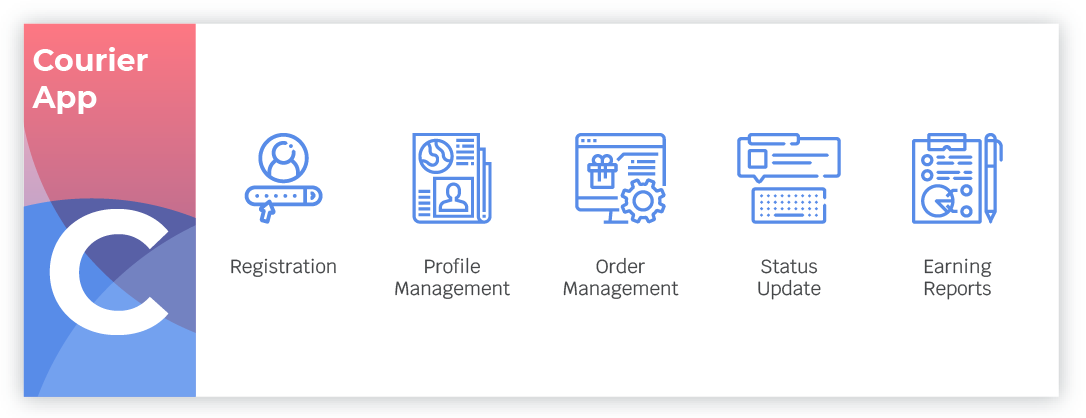
The courier app is guaranteed to be beneficial for your clients in case it features:
- Registration
- Profile management
- Options for managing orders
- Status update (for instance, changes in quantity of items, cancellation, etc.)
- Earning reports (calculator of fees).
Plan UI/UX Design
To build a food delivery app worthy the user's attention, you have to focus on UI/UX design because in most cases it turns out to be a maker or breaker for the project success. The win-win scenario is to plan the small detail with the experienced designers whether you need catchy visuals of food on the opening page or complex elements that will support your feature set for impeccable functionality.
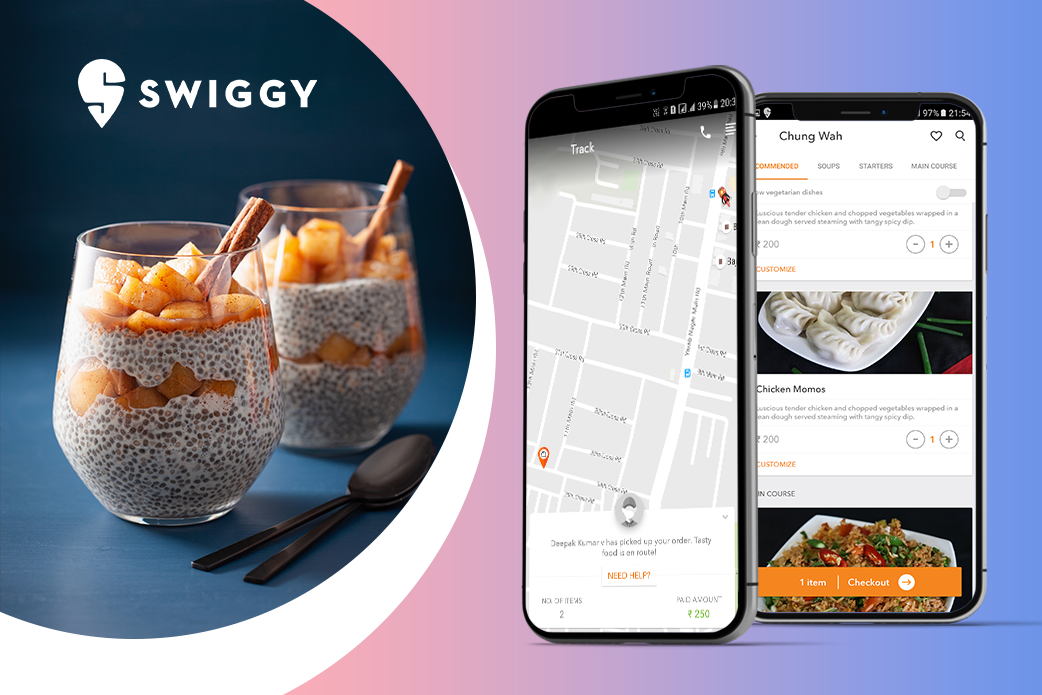
Development Stage
The development stage includes front-end and back-end.
The front-end is what the users see on their screens. The back-end includes servers, databases, and APIs. Depending on the business model you set for your app, user roles and the required features, the tech stack is discussed and defined. Below, there is a list of technologies, tools and APIs assisting within the food delivery app development.
Front-end development: iOS - Swift, Android - Java, Cross-platform - React Native, Web - Angular, ReactJS
Back-end development: Laravel, Phyton, Node.js, WebSockets for chats, Firebase/AWS
Restaurant listing: Grubhub API, FourSquare Places API
Payment gateway: PayPal API, Braintree SDK or Stripe API
Location search and tracking: Google Places API, Core Location Framework, Google Maps SDK, MapKit framework for iOS
Push notifications, SMS and in-app messaging: Amazon SNS, Firebase Cloud Messaging, Twilio
Registrations and authorization: social login via Facebook Mobile SDKs, Google,Twitter APIs.
✔The tech stack can vary depending on the required set of features and the specific needs determined by the scale of your project.
Food delivery app development: Pricing
When estimating the food delivery app development cost, it should be stated that on average the customer part of the app, the restaurant part of the app, the courier part of the app, the admin panel along with backend takes at least 1000 hours of work.
Other major factors contributing to the cost of food app development include:
- What platform you choose for the app development (Web app, native mobile or cross-platform app)
- The level of expertise of the team you work with
- The set of features you confirm for the project
- The rates set for hiring and working with team experts
- The project tech stack
- The central user role (the cost may vary depending on whether you need a customer app, courier app, or restaurant app).
All the detail pertaining to estimation of the project is available free of charge on your request.
Turn your app into money-maker
There are several models that let food delivery apps generate revenue. In particular, on-demand food delivery apps can financially benefit from: 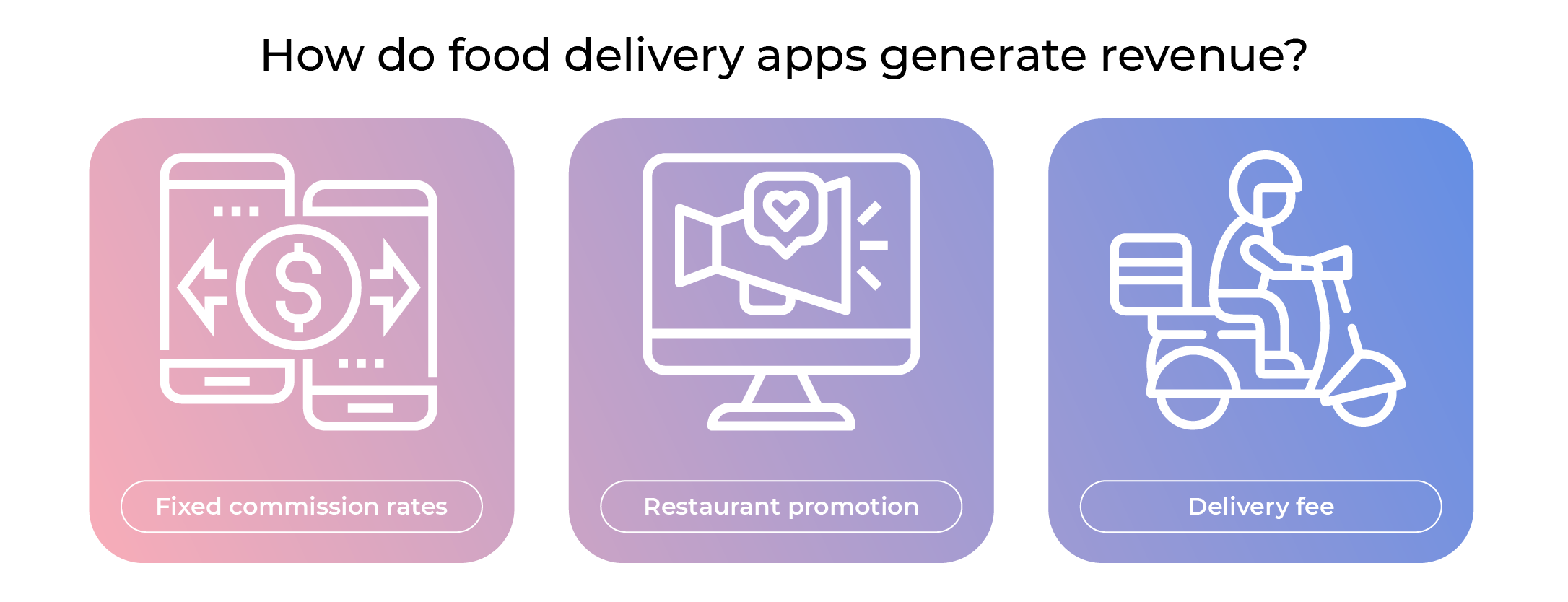
- Setting fixed commission rates
- Engaging in restaurant promotion
- Charging delivery fee.
In Conclusion
Food delivery service goes under rapid changes and it translates in expanding the market for food delivery apps. While engaging customers across Europe, the Americas, Asia, and the Middle East, the food delivery apps offer a wide range of opportunities for restaurants, consumers and courier services.
With the number of delivery players on the rise, home cooking loses the battle, and a greater number of consumers favor the idea of reaching the local restaurant through the food delivery app. To make their experience enhanced and more enjoyable, there come customized solutions from our company on food delivery app development.
Food delivery apps are presented with the following components: Customer app, Restaurant app and Courier app. The Customer panel should include the following basic features:
- Registration and login
- Profile management
- Search for restaurant
- Order placing
- Order checkout
- Order tracking
- Payment gateway
- Ratings and reviews
- Special offers, promotion codes, rewards
- Push notifications
Development of a food delivery application requires the following steps:
- Explore the market
- Define the food delivery business model
- Set the requirements and define user roles
- List the major features of your app
- Prototyping
- Application Design
- Choice of platform
- App development and testing
- Launching the app
Choosing the right software development company is a key factor in project success.
There are several models that let food delivery apps generate revenue. In particular, on-demand food delivery apps can financially benefit from:
- Setting fixed commission rates
- Engaging in restaurant promotion
- Charging delivery fee.
According to McKinsey, the food delivery market is growing faster compared to other sectors of delivery service industry.
The global and local major market players like UberEats, GrubHub, Zomato, Swiggy, Seamless, Eat 24, Deliveroo present diverse business models available on the food delivery market.
The popular apps that represent aggregator model category are Zomato, FoodBoss
The order and delivery app model - UberEats DoorDash
Full-stack model - Dahmakan






